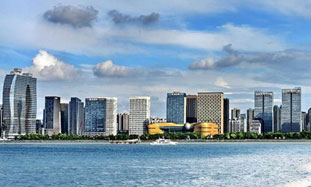Industrial Clusters
Industrial Belt along Jinhua-Quzhou-Lishui Expressway
Jinquli (Jinhua, Quzhou and Lishui) Region is located in the southwest of Zhejiang Province and covers the three cities of Jinhua, Quzhou and Lishui with a total area of 370,000 square kilometers. With superb ecological environment and rich natural resources, Jinquli Region is now displaying its advantages as a relatively backward region compared with other parts of Zhejiang Province and the right time has come for its accelerated development.
Jinquli Region is the origin Qiantang River, Oujiang River, Cao’e River, Feiyun River and Jiaojiang River and features high forest coverage and sound environmental, water, forest and mineral resources. The per capita water reserve of Lishui City is more than triple the national average and its hydroelectric resources that can be harnessed accounts for over 1/3 the total of Zhejiang Province. As the key forest area of Zhejiang, Lishui and Quzhou enjoy a forest coverage ratio of 79.1% and 70.9% respectively. Jinquli Region has a rich reserve of such nonmetals as figure stones, fluorites, limestone, perlites and tuffs. It also boasts of an enormous workforce and rich land resources in Jinheng Basin. Therefore, this region enjoys huge development potential with the improvement of its geographic location advantages and investment environment.
Overall development strategy of Jinquli Region as an economic corridor and ecological belt.
(1) Economic corridor: Jinhengli Region enjoys rich undeveloped resources and advantages as an economically backward region and is a new growth area in Zhejiang. The economic growth of this region mainly concentrates on the corridor along Hangzhou – Jinhua – Quzhou and Jinhua – Lishui – Wenzhou Expressways and Railways. This region is an interim area between the eastern coastal regions and the vast western inland areas and a key access from the Yangtze River Delta and the coastal regions into Middle and Western China.
(2) Ecological belt: five out of the eight water systems in Zhejiang Province are originated from Jinquli Region. In particular, its location on the upper and middle reaches of the Qiantang River and Oujiang River has furnished it with the special and strategic status as the ecological belt of Zhejiang Province. Therefore, it is of vital importance to the harmonious development between human beings and the nature within Zhejiang Province and even the bordering provinces and municipality.
Pursuant to the overall development strategy of Jinquli Region, it aims to develop itself into a new growth area, the biggest region where human beings live in harmony with the nature, an emerging manufacturing base, a key farm product base and a reputable ecological, tourism and recreational resort of Zhejiang Province by 2010 with efforts.
Jinquli Region consists of two types of development areas: one is the area along Hangzhou – Jinhua – Quzhou and Jinhua – Lishui – Wenzhou Expressways and Railways that features better geographic location and conditions and is the focus of population and economic capacity; the other is the vast mountainous area where there are rich environmental resources and a better ecological environment. Confronted with the dual tasks of environment purification and economic development, it needs to maintain its population outflow and is regarded as an ecological economic development area. The goal is to realize the harmonious development of Jinquli Region by building the abovementioned two types of development areas with contrasting population and economic features.
Compared with the Hangzhou Bay region and Wentai Coastal Industrial Strip, the industrial belt along Hangzhou – Jinhua – Quzhou and Jinhua – Lishui – Wenzhou Expressways is relatively underdeveloped and thus enjoys more flexibility in development. Moreover, it features higher ecological requirements and therefore the proper industries shall be chosen for future development.
Industry: Considering the flexibility of development due to its fledging industries, this region shall introduce and encourage growing industries and diversify industries. As this region features high ecological requirements and is located inland with difficulty in transportation, industries with high pollution and energy consumption and industries that its local resources do not support shall be strictly restricted. Considering the substantial difference in industrial development of the three cities, it is necessary to choose the proper key industries for each city recently. However, the three cities shall be integrated economically and division of labor and industrial cooperation shall be encouraged among the cities to realize the integral, harmonious and scale development of industries for the long term. The target is to gradually foster such industrial clusters of autos, daily commodities, machinery, fluorin-related chemicals, food processing and construction materials, etc.
Service industry: the key focus shall be on international trade, modern logistics, tourism and culture, etc so that service industry can develop together with industries.
Modern agriculture: it is necessary to promote the strategic upgrading of agricultural structure, enhance the agricultural industrialization, introduce cutting-edge technology and good species, introduce scale production and modern corporate management in a gradual manner and focus on the development of unique breeding industry, flowering and planting industry, fruits and vegetables and high-quality grains, etc.

 Print
Print Mail
Mail
 20 Cultural Symbols
20 Cultural Symbols Why Zhejiang
Why Zhejiang Experiencing high-tech products at WIC
Experiencing high-tech products at WIC Zhejiang Release
Zhejiang Release Zhejiang News
Zhejiang News